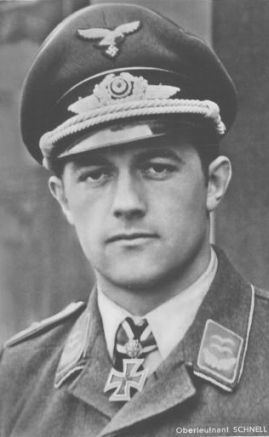Nickname(s) Wumm Years of service 1936–44 Name Siegfried Schnell | ||
 | ||
Battles/wars Battle of FranceBattle of BritainChannel DashDieppe RaidWestern FrontNarva Battles and wars | ||
Major Siegfried Schnell (born 23 January 1916 in Zielenzig, Province of Brandenburg, German Empire – killed in action 25 February 1944 near Narva, Estonia) was German World War II Luftwaffe 93 victories Flying ace and recipient of the Knight's Cross of the Iron Cross with Oak Leaves (German: Ritterkreuz des Eisernen Kreuzes mit Eichenlaub). The Knight's Cross of the Iron Cross and its higher grade Oak Leaves was awarded to recognise extreme battlefield bravery or successful military leadership - for the fighter pilots, it was a quantifiable measure of skill and combat success. At the time of his presentation, it was Germany's highest military decoration.
Contents
Siegfried Schnell was killed in action on 25 February 1944 against the Soviet Narva offensive shot down by an opposing fighter.
Wartime career
A keen glider-pilot, he joined the Luftwaffe in 1936, and by the start of the war in 1939, he was a Feldwebel serving with 4. Staffel of Jagdgeschwader 2 "Richthofen", named after the World War I fighter ace Manfred von Richthofen. Stationed on the western border, he saw very little action until the campaign in France started in May 1940. He got his first victory, a French Bloch 152 fighter on 14 May. He was particularly successful in the Battle of Britain and on 7 November off the Isle of Wight, as operations were slowing down and recently commissioned as a Leutnant (on 1 November), he scored his 20th victory. For this feat he was awarded the Knight's Cross, on 9 November.
The focus of the airwar shifted in the next year to the Eastern Front, however Schnell stayed with JG 2 defending the West. On 24 June 1941, only 2 days after the opening of Operation Barbarossa, he was appointed as Staffelkapitan (Squadron leader) of 9./JG 2. Soon after, he shot down nine Supermarine Spitfires in just two days (8 – 9 July) to reach his 44th victory and was immediately awarded the Knight's Cross with Oak Leaves, at the time being one of the top pilots in Jagdgeschwader 2. He continued to score consistently as the Royal Air Force (RAF) mounted heavier strikes into France, and temporarily held command of III Gruppe from 9 December 1941 to the following 28 January while Kommandeur Hans "Assi" Hahn was on leave. He scored his 52nd (?) victory on 12 February while his unit provided cover for the Kriegsmarine battlecruisers making their 'Channel Dash' back to their ports in Germany. Over the Dieppe Raid on 19 August 1942, he shot down five Spitfires to reach his 71st victory.
After that his scoring rate slowed down as he focussed more on administration and command, and he led his unit in the changeover onto the new Focke Wulf Fw 190—a very rugged dogfighter. In a misguided idea by High Command to rotate the fighter Gruppen between Western and Eastern Fronts, III./Jagdgeschwader 54 (JG 54—54th Fighter Wing) was transferred from Russia back to Germany for Defence of the Reich. Hauptmann Schnell, now with 80 victories, was given command of the unit on 1 May 1943 to train and lead the pilots in high-altitude interception rather than the low-level brawling they were used to on the Eastern Front. On 11 January 1944 he shot down 3 B-17 bombers to reach 90 victories.
On 1 February 1944 he was given command of IV./JG 54, based near Leningrad, and he arrived on 11 February. As mentioned above, command transfers between fronts were rare, given the markedly different combat conditions, and unfortunately Schnell was not lucky to be able to adapt quickly enough. After less than a month and only 3 further victories, he was shot down and killed in his Messerschmitt Me 109 G-6 (Werknummer 411675—factory number) over the Russian offensive for Narva on 25 February 1944.
Posthumously promoted to Major, Siegfried Schnell flew over 500 combat missions and ended with 93 confirmed victories, including 12 4-engined bombers. His tally of 90 on the Western Front made him the 11th most successful pilot over the Western Allies.
